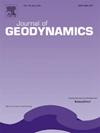The North Dobrogea Orogen revisited: Late Miocene structural reactivation along the Trans-European Suture Zone
IF 2.1
3区 地球科学
Q2 GEOCHEMISTRY & GEOPHYSICS
引用次数: 0
Abstract
The Northern Dobrogea Orogen is the onshore segment of the southeastern termination of the Trans-European Suture Zone, the most prominent tectonic boundary of Europe, and was affected by multiple superposed deformation episodes in the Paleozoic and Mesozoic. Contrary to the widely held notion that the North Dobrogea Orogen has experienced only very mild and local deformation since the mid-Cretaceous, our (U-Th)/He analyses on apatites from Precambrian, Paleozoic, and Triassic basement and cover rocks indicate a well-defined and widespread episode of cooling/exhumation starting in the late Miocene. The high level of data coherence and the fact that all tectonic units of North Dobrogea have been affected by such episode warrants a geological explanation of supra-regional extent. Miocene cooling/exhumation in Dobrogea can be placed in a larger framework of coeval intraplate compressional deformation affecting a wide area ranging from the Greater Caucasus to the Romanian sector of the Black Sea continental shelf. We propose that the structural inversion of inherited structures in the study area is a distant echo of the Arabia-Eurasia hard collision, which started in the mid-Miocene some 1200 km away to the southeast. Low-temperature thermochronologic data for the area north of the Bitlis-Pütürge suture zone of SE Anatolia indicate that the tectonic stresses related to the Arabian collision were transmitted efficiently in the Eurasian hinterland over large distances, focusing preferentially at rheological discontinuities located as far as the northern shores of the Black Sea. Late Miocene far-field deformation in the hinterland of the Arabia-Eurasia collision zone decreases gradually westward from the rapidly exhuming Greater Caucasus, located in front of the area of maximum indentation, through Crimea, to the Odessa shelf and Dobrogea, where deformation has been significantly less and therefore remained underestimated until now.
重游北多布罗格造山带:沿跨欧洲缝合带晚中新世构造的再激活
北多布罗格造山带是泛欧缝合带东南端的陆上段,是欧洲最突出的构造边界,在古生代和中生代受到多次叠加变形的影响。我们对前寒武纪、古生代和三叠纪基底和盖层磷灰石的(U-Th)/He分析表明,从中新世晚期开始,有一个明确而广泛的冷却/挖掘过程,与人们普遍认为的中白垩纪以来北多布罗格造山带只经历了非常轻微的局部变形的观点相反。高水平的数据一致性和北多布罗格亚所有构造单元都受到这种事件影响的事实,保证了超区域范围的地质解释。Dobrogea中新世冷却/挖掘可以放在一个更大的同时期板内挤压变形的框架中,影响从大高加索到黑海大陆架罗马尼亚部分的广泛地区。我们认为,研究区继承构造的构造反转是阿拉伯-欧亚大陆硬碰撞的一个遥远的回声,该碰撞始于中新世中期,东南约1200 km。安纳托利亚东南部bitlis - p ttrge缝合带以北地区的低温热年代学资料表明,与阿拉伯碰撞有关的构造应力在欧亚腹地长距离有效传递,优先集中在远至黑海北岸的流变不连续面。晚中新世阿拉伯-欧亚碰撞带腹地的远场变形逐渐向西减少,从位于最大压痕区前面的快速发掘的大高加索,穿过克里米亚,到敖德萨陆架和多布罗格亚,那里的变形明显较小,因此直到现在仍被低估。
本文章由计算机程序翻译,如有差异,请以英文原文为准。
求助全文
约1分钟内获得全文
求助全文
来源期刊

Journal of Geodynamics
地学-地球化学与地球物理
CiteScore
4.60
自引率
0.00%
发文量
21
审稿时长
6-12 weeks
期刊介绍:
The Journal of Geodynamics is an international and interdisciplinary forum for the publication of results and discussions of solid earth research in geodetic, geophysical, geological and geochemical geodynamics, with special emphasis on the large scale processes involved.
 求助内容:
求助内容: 应助结果提醒方式:
应助结果提醒方式:


